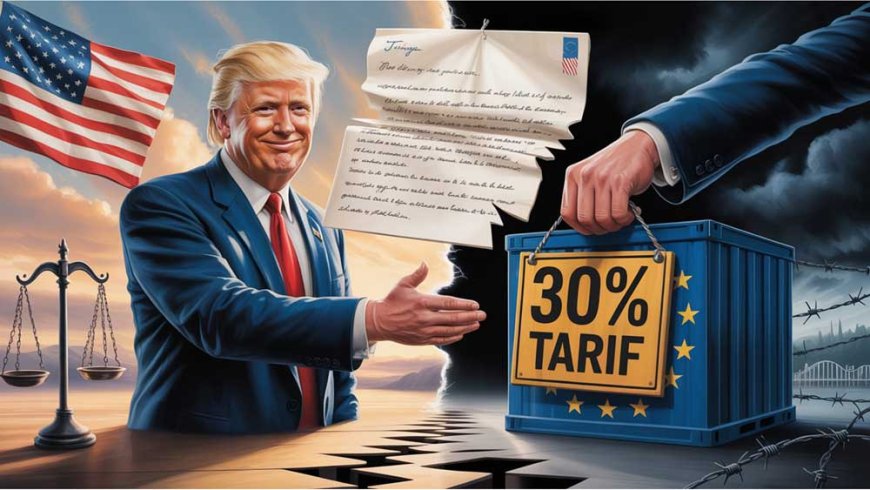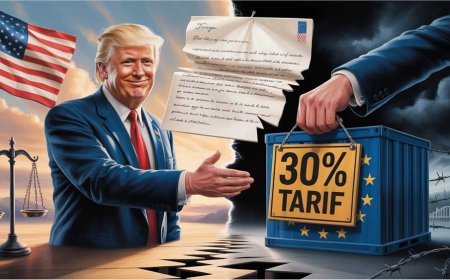Between Flattery and Threats: Anatomy Trump’s Letter to Europe
An in-depth analysis of Trump’s letter to the EU, revealing its contradictory tone, coercive content, and low Shartify Trust Rank of 3/10. Trump’s letter to the European Union presents a striking contradiction: a polite tone masking aggressive trade threats. This detailed, paragraph-by-paragraph analysis exposes the duality of the message—offering partnership while issuing ultimatums. With a Shartify Trust Rank of just 3/10, the letter reflects coercive diplomacy and a unilateral vision of global trade.

Donald Trump's letter to the President of the European Commission is a textbook example of rhetorical dissonance: a schizophrenic blend of formal politeness and aggressive content, in which diplomatic language serves as a thin veil over economic threats. Below is a detailed, paragraph-by-paragraph breakdown of the letter, analyzing its structure, tone, subtext, and the power dynamics at play.
Paragraph 1: Polite Opening with an Immediate Undercut
"It is a great honor for me to send you this letter, as it demonstrates the strength and commitment of our trade relations and the fact that the United States of America has agreed to continue cooperating with the European Union, despite one of our largest trade deficits with you."
- Analysis: The letter opens with a seemingly warm tone — “great honor,” “strength,” “commitment” — only to quickly pivot into a direct accusation: the EU is responsible for a significant U.S. trade deficit.
- Contradiction: Cooperation is framed not as a mutual agreement but as an American concession.
- Power play: The phrase “has agreed to continue cooperating” implies that the U.S. holds the reins and is merely tolerating the relationship.
Paragraph 2: The “Fair Trade” Pretext
"Nevertheless, we have decided to move forward, but only with more balanced and fair TRADE."
- Analysis: The term “TRADE” in all caps is a stylistic Trumpism — an attempt to give moral weight to economic aggression.
- Rhetorical frame: Trade imbalances are recast not as economic phenomena, but as injustices. This prepares the reader for coercive policy under the guise of fairness.
Paragraph 3: Shifting All Blame to the EU
"We must abandon these long-standing, wide, and persistent trade deficits, generated by your tariff and non-tariff policies and your trade barriers..."
- Analysis: Trump shifts all responsibility for imbalances onto the EU, painting it as the sole architect of unfair trade.
- Tone: Politeness is replaced with moral indictment — the EU is no longer a partner, but a violator.
- Double irony: This accusation is addressed using the formal “you,” giving it an air of respect while delivering a sharp rebuke.
Paragraph 4: A Formal Threat in Bureaucratic Language
"As of August 1, 2025, we will impose a modest 30% tariff..."
- Analysis: The 30% tariff is presented as both “modest” and “necessary,” using cold technical language to soften the blow of what is a drastic and punitive measure.
- Framing tactic: Refers to transshipment and tariff evasion, implying EU dishonesty — again eroding mutual trust.
- Key paradox: Calling a 30% tariff “only” 30% is a rhetorical strategy to normalize economic aggression.
Paragraph 5: Carrot After the Stick
"There will be no tariffs if the EU or companies within it choose to build or produce in the United States..."
- Analysis: This is economic blackmail framed as opportunity.
- Subtext: Trump's goal is not simply reducing deficits, but forcing foreign companies to relocate production to the U.S.
- Diplomatic illusion: It’s pitched as an invitation, but functions as an ultimatum: “invest in us, or suffer.”
Paragraph 6: The Tariff Escalation Clause
"If for any reason you choose to retaliate... the amount will be added to the 30% we are imposing."
- Analysis: This is a direct threat against any form of EU reaction, preemptively crushing the idea of reciprocal response.
- Contradictory tone: Phrases like “please understand” and “these tariffs are necessary” suggest reasonableness while imposing punitive constraints.
- Strategic coercion: The U.S. dictates terms, and any disagreement is met with harsher penalties — all wrapped in polite phrasing.
Paragraph 7: Trade Deficit as National Security Threat
"This deficit represents a grave threat to our economy and, in fact, to our national security!"
- Analysis: This is a rhetorical escalation that redefines trade disputes as existential dangers.
- Political move: Invoking national security allows Trump to justify trade actions without going through full congressional oversight.
- Psychological framing: This turns an economic issue into a survival issue, elevating the stakes far beyond trade policy.
Paragraph 8: Conditional Partnership
"We look forward to working with you... if you open your markets and eliminate your barriers..."
- Analysis: The conditional tone here reveals that “partnership” is entirely dependent on EU compliance.
- Negotiation under duress: Offers of cooperation are contingent on surrendering sovereign policy — a one-way street.
- Ambiguous language: “We may consider amending this letter” — the only "concession" offered is to edit the threat, not withdraw it.
Paragraph 9: Jarring Closing Optimism
"You will never be disappointed by the United States of America. Thank you for your attention..."
- Analysis: The closing sentiment is dramatically disconnected from the rest of the letter.
- Rhetorical schizophrenia: After threats, tariffs, and accusations, the letter ends with a cheerful patriotic slogan, revealing Trump’s habitual self-branding.
- Emotional manipulation: Designed to project strength and reliability, even after undermining trust.
Final Remarks: The Illusion of Partnership
Trump’s letter is not a diplomatic gesture — it is a unilateral ultimatum dressed in ceremonial language. The blend of formality and confrontation, flattery and coercion, reveals:
- A fundamental disregard for bilateral negotiation.
- A self-perception of indispensability: Trump assumes the U.S. holds all the leverage.
- A tendency to redefine aggression as fairness, and coercion as opportunity.
The letter showcases Trump’s classic negotiation style: appear cordial while delivering a blow, frame retaliation as irrational, and offer partnership only on non-negotiable terms. In doing so, it underscores a broader geopolitical message:
“America First, and only on our terms.”
Shartify Trust Rank: 3 / 10
Criteria:
- Transparency (2/10): The letter uses diplomatic language but masks clear economic coercion. It presents aggressive trade measures as “fair” and “necessary,” lacking honest disclosure of true intent.
- Intent (3/10): The primary goal is unilateral advantage and pressure on the EU rather than genuine cooperation. While framed as partnership, it is conditional on EU submission to U.S. demands.
- Tone (4/10): Politeness is superficial and contradicted by threats and ultimatums. The schizophrenic mix of cordiality and aggression undermines trustworthiness.
- Reliability (3/10): The letter signals potential for escalation, unpredictability in tariff adjustments, and economic retaliation, making it unreliable as a foundation for stable relations.
- Consistency (3/10): The messaging is inconsistent, mixing offers of partnership with rigid ultimatums and punitive measures, creating confusion about actual policy stance.
Final:
The letter ranks low on the Shartify Trust Scale because it is primarily a tool of coercion disguised as diplomacy. It lacks genuine openness and fosters uncertainty. The trust score of 3/10 reflects that it is not a reliable or sincere communication but rather a strategic ultimatum with limited room for constructive dialogue.
What's Your Reaction?
































